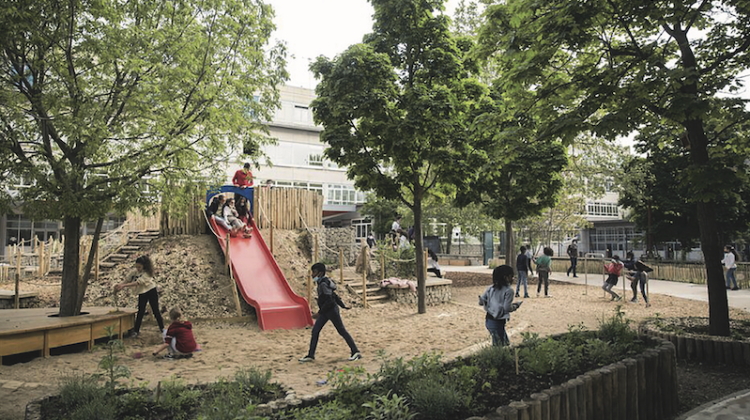Highlighting the Power of Neighborhoods for a More Equitable and Resilient Future

Renovated OASIS schoolyard at the École Élémentaire Maryse Hilsz in Paris. Credit: Joséphine Brueder

Canal-side path in Bang Bua, an area of Bangkok with several Baan Mankong upgrading projects. Credit: Cak-cak
When discussing responses to the challenges of climate change, we tend to focus on international negotiations, national agendas, city resilience and adaptation, or the discrete choices we as individuals are making. How might designers and planners intervene at scales that are in between the extremes of large and small scale action? In a paper for Built Environment, Zachary Lamb and Lawrence Vale re-envision the neighborhood unit as a medium for accelerating equitable responses to climate risks and increasing resilience to climate impacts.
“Although we did not set out to focus on neighborhood-scale interventions, we found that the examples offering the most encouraging results [in advancing equitable resilience to climate change] all had some neighborhood focus,” write Lamb and Vale. However, they go on to say that “... to be an effective unit of intervention for planners, we need to add to the definition of a neighborhood, expanding beyond their origins as middle-class enclaves. Neighborhoods must also encompass settlement types that are home to disadvantaged people. Second, neighborhood scale analysis and action must be linked to broader spatial and political domains. Finally, physical interventions in neighborhood built environments must be paired with social and institutional reforms that broaden agency to give disadvantaged residents the power to act in the face of climate change and other threats.”
Lamb and Vale draw upon a diverse range of global case studies from neighborhoods in cities such as New Orleans, Louisiana (USA), Bangkok (Thailand), Cochabamba (Bolivia), Pune (India), and Portland, Oregon (USA). These case studies provide the foundation for what Lamb and Vale identify as the “four LEGS” of equitably resilient neighborhoods: 1) Livelihoods: what functions and services are provided at the local scale; 2) Environment: how environmental threats are prioritized and addressed; 3) Governance: who controls how decisions are made about the management and structure of residential life; and 4) Security: who determines who belongs to a community and how members are protected from displacement.
Lamb (PhD ‘18, MArch ‘10) is an assistant professor in the Department of City and Regional Planning at UC Berkeley. His research focuses on the role of urban planning and design in shaping uneven vulnerability and resilience in the face of climate change. Vale is the Ford Professor of Urban Design and Planning and the Associate Dean of the School of Architecture and Planning at MIT. His research examines the history, politics, and design of American public housing, as well as two decades of work on the design-politics of urban resilience including leadership of the Resilient Cities Housing Initiative (RCHI).
The findings presented in their paper build off the research conducted for their forthcoming book, The Equitably Resilient City: Solidarities and Struggles in the Face of Climate Crisis (MIT Press, 2024). “This article was a great space to introduce this framework and demonstrate its applicability to folks interested in how cities and neighborhoods can equitably adapt to a changing climate,” says Lamb. “Our forthcoming book, which will be provided via Open Access from MIT Press, is the full articulation of our framework and provides greater detail of the case studies we were only able to briefly discuss in the article.”
Read “A Neighbourhood Unit for Equitable Resilience” via Open Access


